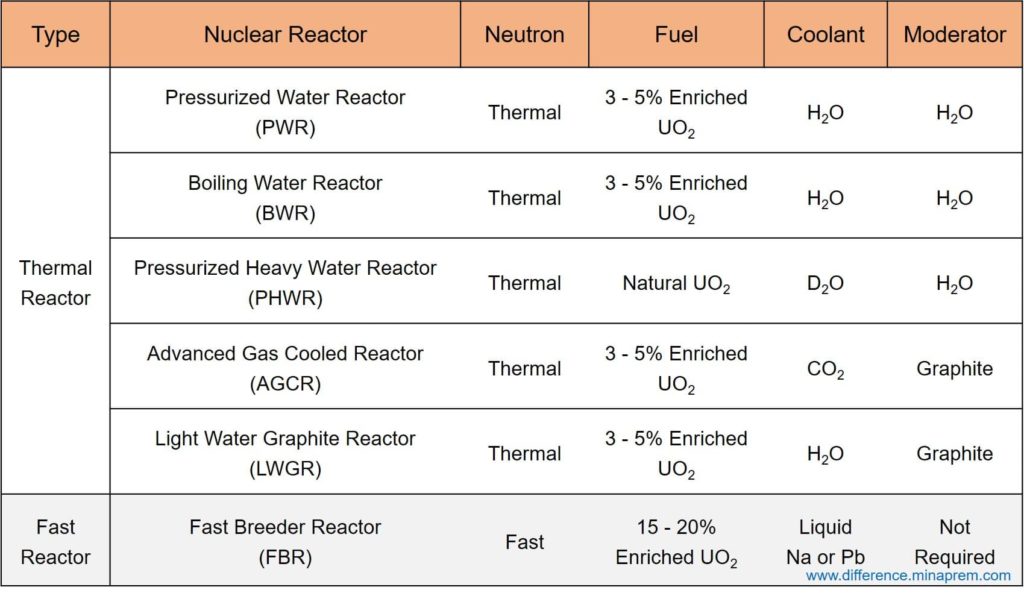In the nuclear power plant, the thermal energy generated by nuclear reaction (fission or fusion) is indirectly used to rotate the steam turbine to generate electricity. Nuclear fission power plants gained popularity owing to the easiness of initiating and controlling the fission reaction as compared to that of fusion. In fission power plants, nuclear fuel (mostly uranium fuel) is made to undergo fission reaction by bombarding it with high velocity neutrons. Reactor is the heart of nuclear power plant where the nuclear reaction takes place. It is a large enclosure where the fuel pallet or rod, its holder and necessary controlling elements are kept. A low temperature coolant (usually a liquid, such as normal water, heavy water, liquid sodium, etc.) is pumped into the reactor where the heat obtained from nuclear reaction is transferred to this coolant. Accordingly, the temperature of the coolant increases. Sometimes this coolant is allowed to change its phase (i.e. from liquid to vapour), else the pressure at the exit of the reactor is increased in such a way that the coolant remains in liquid phase even at very high temperature. If the reactor output is gaseous then it can be directly fed to the steam turbine. If the reactor output is liquid then a secondary loop is employed to obtain gaseous fluid for driving the turbine. In case of thermal reactors (where fission is initiated by thermal neutrons that has energy of 0.025eV and velocity of 2.2km/s), a moderator is mandatorily required to reduce energy of the prompt neutrons.
Even though the basic working principle is same for every fission power plants, thermal reactors can be classified in several categories based on the moderator and coolant fluid, namely, Boiling Water Reactor (BWR), Pressurized Water Reactor (PWR), Pressurized Heavy-Water Reactor (PHWR), Advanced Gas Cooled Reactor (AGCR), etc. Both in PWR and PHWR, the coolant pressure at the outlet of the reactor is maintained in such a way that the coolant does not boil. A dedicated pressurizer unit is employed for this purpose. Thus the reactor output is high temperature coolant in liquid phase, and hence a secondary loop is employed where the heat from this hot coolant is transferred to the working fluid (water) of the secondary loop to obtain high pressure steam for driving turbine. After the heat transfer, the coolant is pumped back to the reactor to complete cycle of the primary loop. Even though the working principle of PWR and PHWR are quite similar, normal water (H2O) is used as coolant in PWR, while heavy water (D2O) is used as coolant in PHWR. The respective coolant also serves the purpose of moderator in both the cases; however, PHWR reactors are designed in such a way that the moderator is not allowed to physically mix with the coolant (though both are heavy water). One advantage offered by heavy water moderator is the increase in fission cross-section and thus low enriched uranium can be used as reactor fuel. While PWR requires 3 – 5% enriched uranium to sustain chain reaction, the PHWR reactors can be operated without enrichment (i.e. at natural concentration of about 0.7% uranium-235). Various similarities and differences between PWR and PHWR are given below in table format.
Similarities between PWR and PHWR
- Both PWR and PHWR fundamentally consist of two loops – (i) primary loop where heat from the nuclear reaction in transmitted to coolant, and (ii) secondary loop where heat from the coolant is transferred to working fluid for driving turbine.
- Pressurizer is used in both the cases to restrict the coolant from boiling by maintaining a very high pressure.
- Control rods are used in both type or reactors for controlling the rate of nuclear fission reaction and thus the rate of heat generation.
- Due to presence of two different loops, there exists a less chance of radioactive element spreading for leakage in turbine.
- Both the reactors work on the thermal neutrons. This indicates that the nuclear fission is initiated by a thermal neutron, rather than a fast neutron.
Differences between PWR and PHWR
| Pressurized Water Reactor (PWR) | Pressurized Heavy Water Reactor (PHWR) |
|---|---|
| In PWR, the coolant also serves the purposes of moderator. So the same fluid acts as coolant-cum-moderator. | In most prevalent design of PHWR (i.e. at CANDU design), the coolant is kept separated from the moderator. Thus the moderator fluid don’t mix with the coolant. |
| In PWR, normal water or light water (H2O) is used as coolant-cum-moderator. | In PHWR, heavy water (D2O) based on deuterium is used as coolant, and also as moderator (but they are not allowed to mix). |
| Enriched uranium with around 3 – 5% U-235 isotope is used as fuel in the PWR reactors. | Mostly natural uranium that has around 0.7% U-235 is used as fuel in PHWR reactors as D2O has negligible neutron absorption cross-section. |
| Uranium enrichment is costly and time consuming process. Thus the fuel for PWR reactors is costlier. | PHWR reactor fuel is cheaper as it utilizes naturally available uranium as reactor fuel. |
| The regular water (H2O) that is used as coolant-cum-moderator in PWR is abundantly available and is cheaper. | The heavy water (D2O) that is used as coolant and moderator in PHWR is highly expensive. |
| Fluid in the primary loop or coolant loop of PWR is maintained at higher pressure (around 15 MPa). | Fluid in the primary loop of PHWR is maintained at comparatively lower pressure (8 – 10 MPa). |

References
- Introduction to Nuclear Reactor Physics by R. E. Masterson (2017, CRC Press).
- Fundamentals of Nuclear Reactor Physics by E. E. Lewis (2008, Academic Press).